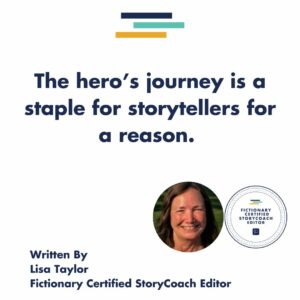
What can the stages of the hero’s journey offer you and your characters? How can you use the hero’s journey to enhance your story?
I’m not going to promise it can give you a step-by-step guide to a great story or offer magic solutions to solve plot-block.
So what can it offer?
While it isn’t the magic elixir, the hero’s journey stages can give you inspiration, ideas, and support as you write and edit your story. After all, this monomyth structure has a long, storied history.
Through analysis of myths and stories, the hero’s journey was born. Popularized by Joseph Campbell and refined by Christopher Vogler, the hero’s journey presents a narrative arc evident in stories told through the ages in a wide range of media.

What is the Hero’s Journey?
The hero’s journey is a familiar guide for storytellers.
Following a hero, the story integrates external and internal growth as the hero leaves home to meet adventure and challenges, finally returning with both the object of the quest and a new realization of self.
The journey has three basic stages:
- Departure,
- Initiation, and;
- Return.
In the departure, the hero begins in the ordinary world, gets a call to adventure which is often refused until a mentor/helper supports the hero in accepting the call.
Through the initiation stage, the hero enters a special world where they are challenged to use new knowledge to gain the object of the quest.
The return comes as the hero returns home, changed.
17 Steps and Examples
These stages are divided into 17 steps in Campbell’s monomyth.
Slight changes have been made from the traditional names of the steps to reflect the definitions.
Examples are drawn from a variety of stories.
As you read, remember that a story may not follow this exact order and may skip steps.
Campbell developed this list through analysis of numerous stories. What these steps offer are possible additions or connections you can use to add variety, tension and action to your story’s through line.

The Hero’s Journey, Part 1: Departure
Step 1: Call to Adventure
Something or someone draws the hero from the ordinary world with a problem, threat, or opportunity.
In Beowulf, the hero learns of a monster who is killing people in the kingdom.
In The Hunger Games, this is the moment that Prim is called to be a Tribute, much to Katniss’s horror.
Through the call to adventure, the reader is promised a story goal.
Step 2: Refusal of the Call
The hero hesitates.
This may be due to fear or doubt. Eventually, or immediately, the hero accepts the call to adventure.
While Beowulf and Katniss immediately accept the call, Frodo feels he is not the one to be entrusted with the ring. By watching this struggle, the reader sees that the hero is human and develops a connection with the character.
Step 3: Meet Mentor/Aid
Traditionally, this would be supernatural aid.
The hero encounters someone who gives advice, power or a gift.
For Frodo, this was meeting Gandalf. For Dorothy, it was meeting Glinda the Good Witch.
In any form, the help given ensures the story won’t end too quickly as the hero has some of the skills or knowledge needed to survive.
Step 4: Crossing the Threshold
From this moment, the hero is moving toward the quest and away from the comfort of the ordinary world. Katniss gets on the train to the Capitol. Frodo and Sam leave the Shire.
The journey begins.
Step 5: Point of No Return
The hero meets the first obstacle and knows that there is no going home from here.
Dorothy must leave the house and begin her search for the Wizard of Oz with only Toto as company. As the reader sees the hero separated from home and who they were, empathy and connection can grow even stronger.

The Hero’s Journey, Part 2: Initiation
Step 6: The Road of Trials
As part of the quest and transformation, the hero encounters trials and ordeals, meeting with both success and failure along the way.
Katniss trains for and takes part in the Games. Frodo and his allies meet dangers.
The road of trials creates action and adventure for the reader as the hero moves toward the story goal.
Step 7: Meeting with Allies
The hero gathers a squad to help navigate the challenges.
Dorothy meets the Tinman, the Scarecrow and the Lion on her way to the Wizard. Katniss has Rue and Peeta as allies during the Games.
Step 8: Temptation
The hero is tempted to abandon the quest, often for love or power.
Tolkien has created a constant temptation in the ring. Dorothy is tempted to abandon the ruby slippers to protect Toto.
Showing the hero’s struggle with temptation allows the reader to see both the strength and weakness of the character.
Step 9: Overcome Judgment
Acknowledging doubts and fears, the hero recognizes how life has been controlled by external powers to this point.
Within this turning point, the hero:
- Confronts the reason for the journey,
- Recognizes growth, and;
- Exchanges innocence for experience.
Katniss understands the manipulation of the Gamemaker in announcing there can only be one winner. Dorothy confronts the Great and Powerful Wizard of Oz.
Step 10: Climax/Realization
Out of the confrontation, the hero gains understanding of ultimate purpose and is ready to use this new knowledge and/or ability in meeting the final challenge.
Katniss and Peeta take their death into their own hands by eating the poison berries. Dorothy discovers that the wizard is just a man.
Step 11: The Ultimate Treasure
The hero attains the goal and completes the journey.
The Gamemaker changes the rules and makes both Katniss and Peeta winners of the Games. Dorothy learns that each of them already possess the thing they desire and that the ruby slippers can take her home.

The Hero’s Journey, Part 3: The Return
Step 12: Refusal of the Return
A victorious hero may balk at returning to the ordinary world.
Whether due to recognition of internal change or fear of the future, a hero may want to stay in the special world.
While most of the heroes mentioned so far only hesitate for a moment, if at all, Dorothy recognizes that she will have to leave Oz and her friends behind to return home.
Step 13: The Magic Flight
The hero must evade those who want the treasure back.
Frodo and the Fellowship must flee the Orcs and Goblins. This step offers an exciting final flight from danger!
Step 14: Rescue from Without
In a mirror to the meeting with mentor/aid, the hero meets an ally who helps guide them home.
This may be more emotional than physical; Frodo needs time and Gandalf’s guidance to deal with the shock of returning home.
Step 15: The Crossing of the Return Threshold
This is the moment the hero steps back into the ordinary world. The hero has changed and the world may have changed too.
When Frodo returns to the Shire, he has changed and he finds it has as well. As Katniss returns, she knows that she has strong enemies in the Capitol. When Dorothy returns, she knows there is no place like home.
Step 16: Master of Two Worlds
The journey has changed the hero. Upon settling back into the ordinary world, the hero discovers ways to thrive.
Frodo saves the Shire. Katniss becomes the Mockingjay.
Step 17: Freedom to Live
The hero is free to live life in peace. In a series, this peace may be short-lived.
Katniss knows that she will be called to adventure even as the story ends. This can be a typical happy-ever-after or a happy-for-the-moment, but not all stories end happily.

What can the Stages of the Hero’s Journey Offer You?
A great story needs a strong story arc. There must be a protagonist who is pursuing a story goal. There must be something at stake if the goal isn’t achieved.
A story has a beginning, middle and end.
Begin with a problem that must be solved and clear stakes if it isn’t solved. Build a middle with the struggle of finding a solution and a turning point along the way. End with a resolution that shows that the problem is solved, or maybe that it is unsolvable.
Then, look to the hero’s journey for adventure and inspiration along the way. Within this basic and essential throughline, the hero’s journey offers options for plot and character development. Use the steps above to inspire a new scene, to add a new twist or to develop empathy for your protagonist.
Conclusion
The hero’s journey is a staple for storytellers for a reason. It is almost ingrained into our subconscious. With knowledge and creativity, the stages of the hero’s journey can be a little magic elixir for your story after all!
Further Reading
Want to write a great hero? Check out this blog by James Gallagher
Article Written by Lisa Taylor

Stories are powerful. Through my experience as an educator and librarian, I’ve explored how stories work and supported writers in finding their voices and honing their craft.
As a Fictionary Certified StoryCoach Editor, I offer a thorough, objective structural story edit that honours your voice, recognises and celebrates your skill, and offers clear, actionable ideas on ways to make your story shine even more. You can reach me through the Fictionary Online Community.
Want to tell stories guaranteed to delight readers?
Sign-up for you 14 day free trial of StoryTeller today!


